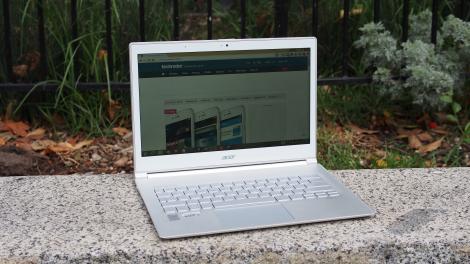
Introduction and design
With an already stunning design from last year, most of the improvements Acer made to this year’s Aspire S7 come under the hood. This year’s model bears the same luxurious white glass aesthetics from last year, but Acer gave the S7 a speed boost with the latest generation of Intel Core processor and integrated Intel HD graphics.
To give the Aspire S7 its minimalist and refined style, Acer chose to go a different route than most of its competitors. Unlike the metal-clad Dell XPS 13 and Apple MacBook Pro 13-inch with Retina display, the S7’s design is reminiscent of Apple’s iPhone 4 design, with a metal frame holding a glass sandwich together.
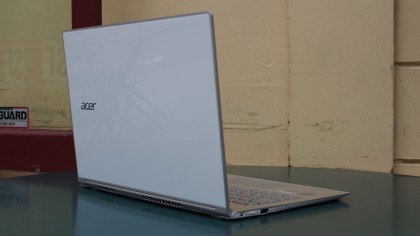
The Aspire S7 takes on a more minimalist, and less gaudy, design than the faux-leather cover on last year’s Samsung Ativ Book 9, a decision that Samsung has since abandoned for a more simple metallic finish on this year’s iteration.
Design
Fashionable, luxurious and chic are a few adjectives that I would use to describe the Aspire S7’s glass design. The white finish and aluminum trim makes the Ultrabook unique in the Ultrabook market, appealing to those who prefer white electronics given that most laptops today come in silver or black, and Apple has since abandoned the color option on the discontinued plastic MacBook.
With a 12.72 x 8.78-inch (32.31 x 22.30cm) footprint and a uniformly slim 0.51-inch (1.30cm) frame, the Aspire S7 comes in at 2.87 pounds (1.30kg). This means that the Aspire will occupy slightly more real estate on your desk compared to the smaller 12.35 x 8.62-inch (31.37cm x 21.89cm) footprint of the Apple MacBook Pro 13-inch with Retina display ($1,299, £833, AU$1,766), but the MacBook is thicker at 0.71 inches (1.80cm) and weighs more at 3.48 pounds (1.58kg). With Apple’s option, you’ll gain a higher resolution display, but lose the Aspire’s touchscreen.
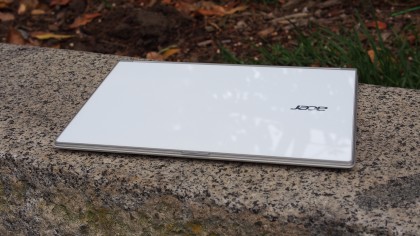
Neither notebook is as light as the Lenovo LaVie Z ($1,499 US-only, but about £952, AU$1,936), which comes in at just 1.87 pounds (0.85kg), giving it the title of the lightest laptop in the world.
Dell’s XPS 13 ($799, £512, AU$1,086) with its bezel-less infinity display screen takes up even less desk space with its compact 11.04 x 7.74-inch (28.04 x 19.66cm) footprint. The XPS 13 has a similar thickness as the Aspire, but appears slimmer with its tapered design, similar to the Apple MacBook Air ($999, £640, AU$1,358).
The white lid of the Aspire S7 is very slim. A silver Acer logo is etched onto the left-hand side of glass lid. Power on the Aspire S7 and the Acer logo glows white, similar to how the Apple logo glows on the MacBook Pro.
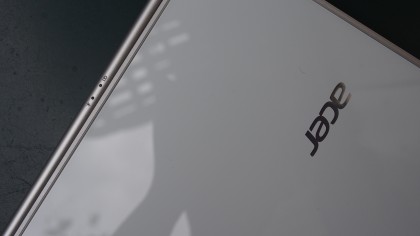
The glass attracts a fair amount of fingerprint, but thankfully the white color does a good job of concealing fingerprints. It’s unclear how well the Gorillas Glass lid can withstand scratches over time compared to metal and plastic notebooks.
On the other side of the lid is a bright 13.3-inch display. Our review unit comes with a full HD 1080p touchscreen making it ideal for watching videos and movies. For productivity tasks, I felt the 16:9 aspect ratio to be a bit too narrow and would have preferred the 3:2 aspect ratio of Microsoft’s Surface Pro 3 ($799, £512, AU$1,086) or the 16:10 aspect ratio found on Apple’s 12-inch MacBook ($1,299, £833, AU$1,766).
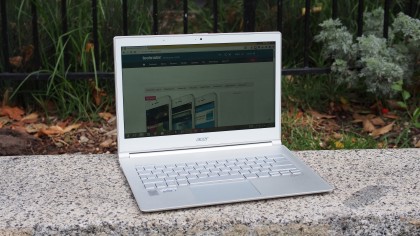
Surprisingly, even though last year’s model can be configured with a WQHD screen, bringing the resolution to 2,560 x 1,440 pixels, this year’s model is capped at 1,920 x 1,080 pixels, making the 2015 Aspire S7 seem like a downgrade for those chasing a Windows version of Apple’s 13-inch MacBook Pro with Retina display.
The wide viewing angle and 180-degree hinge makes the Aspire S7 an attractive option for mobile professionals and students. Coupled with the compact frame and light weight of the laptop, the Aspire these screen features make peer-to-peer collaboration easier for projects and small presentations.
Unfortunately, unlike newer convertibles, like the Lenovo LaVie Z 360 ($1,599, £1,026, AU$2,138) and the HP Spectre x360 ($999, £899, AU$1,899), the hinge on the Aspire S7 doesn’t go all the way to 360 degrees to allow the notebook to convert into a tablet.
While the display of the Aspire S7 is more than bright enough for indoor use, the screen is instantly washed out under a bright sun. Those looking to do most of their productive work indoors shouldn’t have any issues with the screen, but the display shows glare and reflections under the sun.
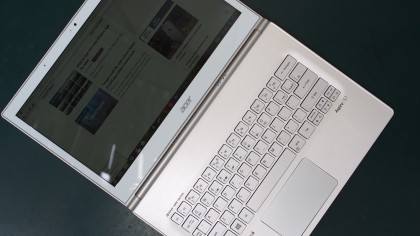
The Aspire S7 uses a barrel hinge design, which is unique for a consumer-class Ultrabook as it allows you to open the screen out to 180 degrees. This hinge allows the screen to lay flat, and for students looking to use the Aspire S7 in classrooms, this allows for better peer-to-peer collaboration. Lacking a 360-degree hinge, the Aspire S7 is not a convertible and can’t be used as a tablet like the HP Spectre x360.
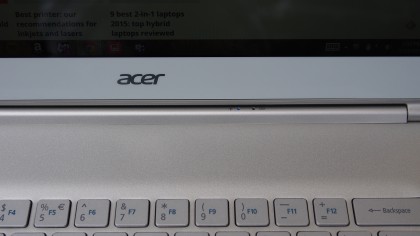
There are also LED light indicators on the barrel, which are visible whether the laptop is closed or open, and gives you a quick visual on whether the system is in standby mode and if it’s charging. The plastic cover surrounding the hinge on to the Aspire S7’s body isn’t as secure as I had hoped – apply a bit of pressure to the silver plastic and the hinge cover pops out of place. I am not sure if this is a design flaw or just an anomaly with my review unit.
Keyboard
Opening up the lid, you’ll find an aluminum keyboard deck and silver keys. Even though the Aspire S7 comes with full-sized keys arranged in an island-style layout, the keyboard is missing a dedicated row for the function keys. Instead, the function keys live alongside the top number row, and the keys are accessible with the Fn button.
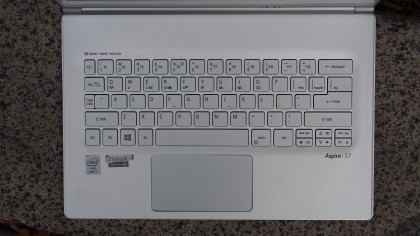
Because of the more compact keyboard arrangement, Acer had to shuffle around some symbol keys. This means that the Caps Lock button has been compressed, the Delete key has been moved from the top to the bottom next to the arrow keys and the tilda key ( ) has found a new home next to the miniaturized Caps Lock.
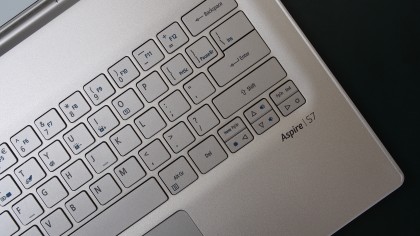
Despite coming with full-sized keys, Acer made some compromises to fit everything into the Aspire’s thin frame. The key caps are flat on the Aspire S7, and key travel is shallow.
Even though the keys don’t move in as far as on a MacBook Pro when depressed, there is more key travel compared to Apple’s MacBook. Key travel feels about on par as the Microsoft Surface 3 with Microsoft’s Touch Cover keyboard case.
The keyboard backlight glows a blue-green hue when you’re typing in the dark. The choice of color appears less harsh on my eyes compared to the bright white LED backlighting on competing notebooks when typing in darkened environments, but the color seems to jar with the white aesthetics of the hardware.
Just below the keyboard is a large trackpad. Similar to the design of the touchpad on Apple’s MacBook line, the trackpad is a large, single button affair, meaning you can press the trackpad to register a click. Pressing on the left side tells Windows you’re trying to perform a left click, and pressing on the right side of the trackpad indicates a right click.
A white sheet of matte plastic covers the bottom of the laptop. It’s unclear if stains on the undercarriage will be an issue over long-term use as they were on the white plastic MacBook. Bottom firing stereo Dolby-branded speakers are also located at the bottom.
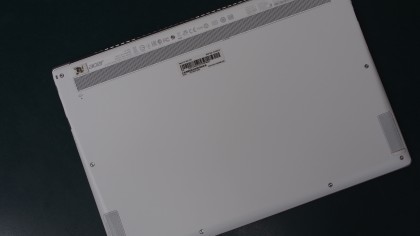
Despites its thinness, the Aspire S7 was able to deliver left- and right-channel sound isolation for stereo sound. There is also rich audio fidelity, and even at higher volumes there is minimal sound distortion.
The side-mounted power button on the left-hand side sandwiched between the USB 3.0 port and power connector is an odd choice. Given the spacious keyboard deck on the Aspire S7, it’s curious why Acer didn’t place the power button there.
Specifications and performance
With this year’s model, Acer boosted the processor to the latest Intel Broadwell processor while at the same time dropping the 2K WQHD resolution screen down to a 1080p display.
The Broadwell-equipped Aspire S7 is available in a single configuration:
Specifications
- Processor: 2.4 GHz 5th Generation Intel Core i7-550U (dual-core, 4MB cache, up to 3.0 GHz with Turbo Boost)
- Graphics: Intel HD Graphics 5500
- RAM: 8GB, dual channel
- Display: 13.3-inch, 1,920 x 1,080 touchscreen
- Storage: 256GB SSD
- Camera: Built-in 720p
- Ports: 2 x USB 3.0 (with one power-off charging), HDMI with HDCP support, combo headphone and microphone jack, SD memory card reader, Mini DisplayPort, charging port, 802.11ac Wi-Fi (dual-band), Bluetooth 4.0, Intel Wireless Display, TPM 1.2
- Battery: Four-cell, 10-hour rated
- Weight: 2.87 pounds
- Size: 12.72 x 8.78 x 0.51 inches (W x D x H)
The Aspire S7 benefits from a generous selection of ports. Even though it has the same number of USB ports as the Dell XPS 13, it’s more consumer-friendly with a built-in HDMI port. Apple’s MacBook has even more ports, with two Thunderbolt ports in addition to the two USB ports and HDMI output.
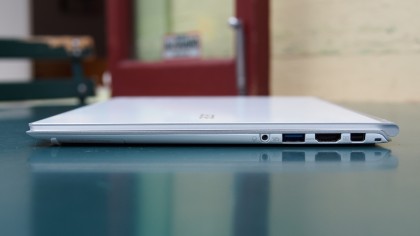
The Dell and MacBook come with options for higher resolution screens. However, only the Dell and Aspire S7 come with options for a touchscreen display whereas Apple uses a non-touch display for all of its notebooks. Stated battery life on all three units is about the same.
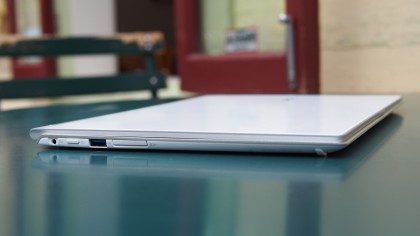
Here are the complete results from this year’s model:
Benchmarks
- Cinebench: CPU: 193points; GPU: 24 fps
- PCMark 8 Home: 2,703
- PCMark 8 Home battery life: 3 hours and 38 minutes (with screen set to 50% brightness)
- 3DMark: Fire Strike: 693; Sky Diver: 2,585; Cloud Gate: 4,955
Performance
Despite the jump to Broadwell and a lower resolution display than last year’s model, benchmarked performance on the 2015 Aspire S7 is slightly worse. Whereas last year’s model scored 231 points using Cinebench’s processor benchmark with a weaker dual-core Intel Core i5 processor, this year’s i7 model only posted a score of 193 using the same test.
For comparison, Cinebench noted that systems with a dual-core Intel Core i7 processor with a slightly faster 2.6 GHz clock speed posted a processor score of 279, significantly ahead of the results achieved by the Aspire S7.
Compared to this year’s Dell XPS 13, the Cinebench results from the Aspire S7 are also lower, despite the XPS 13 coming with a weaker Intel Core i5 processor and a higher resolution QHD screen. A higher resolution display is more taxing on the processor and GPU given the increase in pixel count. The XPS 13 scored 258 points on the processor benchmark and achieved 29 fps on the graphics test.
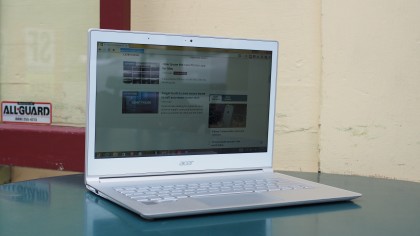
However, the Aspire S7 performed better than the XPS 13 on the PCMark test, and results for the 3DMark benchmarks were similar for the two systems. The XPS 13 scored 2,104 points on the PCMark 8 test. These results make sense given that the Aspire S7 has a better processor than the XPS even though both models share the same integrated Intel HD Graphics 5500 GPU.
One possible explanation for the discrepancy in the Aspire S7’s posted benchmark scores given its solid hardware specifications is the amount of pre-installed software. Our review unit ships with a number of game titles like Zuma’s Revenge, Polar Bear’s First Frame, Bejeweled 2 Deluxe and more. Additionally, there were a number of video editing utilities, photo software, Acer Theft Shield, Drop Box, video players and photo gallery software, McAfee suite, PDF reader and Acer tools preloaded.
Once the bloatware was uninstalled, the Aspire S7 was able to achieve 231 points on Cinebench’s CPU test, a significant bump from its score of 193 points out of the box.
Even under heavy load when the fan is on, the Aspire S7 manages to stay cool except in the area around the hinge. I found that this isn’t a big deal unless I am using the Aspire on my lap. In this case, the heat from the Aspire S7 transferred to my knees and made the computing experience uncomfortably hot.

For normal web surfing, watching a few short video clips, chatting on instant messaging clients, opening Microsoft Excel files and working inside Google Docs while connected to Wi-Fi with the screen brightness set at 50%, I got more than seven hours of battery life. The Aspire S7 could last almost a full work day, but real world battery performance is short of Acer’s 10-hour rating.
Verdict
If you have a passion for white electronics, the Aspire S7’s looks alone may seal the deal, but the laptop is more than just a pretty face. Acer packs in Intel’s Broadwell Core i7 processor, a battery that lasts close to a full work day, and plenty of storage and RAM into a sleek body.
What we liked
The gorgeous design and white aesthetics makes for a stunning laptop. Acer not only filled the void created when Apple discontinued its white-hued plastic MacBook, but the Aspire excels in the looks department with premium glass and metal materials.
If you take time to remove the bloatware that comes preinstalled on the Aspire S7, you’ll be rewarded with fast and powerful performance thanks to Intel’s Core i7 processor. Design professionals who may be drawn to the Aspire’s aesthetics may want to stay away if their workflow requires a dedicated GPU to do heavy lifting, but the Intel HD Graphics 5500 is more than capable for general computing tasks and casual gaming.
If you’re looking for an entertainment laptop, the Aspire S7 has a gorgeous screen, albeit one that’s capped at 1080p, and impressive stereo speakers.
What we disliked
The biggest problem with the Aspire S7 is that Acer saddled the laptop with too many software titles, which slows the system down. Once the pre-installed bloatware is removed, performance increased in our benchmark tests.
Adding a 360-degree hinge to the slim and attractive design of the Aspire S7 would make it an attractive convertible notebook that would make the system more competitive with premium convertibles, like the HP Spectre x360 and Lenovo LaVie Z 360. The 180-degree hinge on the Aspire S7 is still good for productivity and enhances peer-to-peer collaboration, but if you want to travel with a tablet, you’ll have to add the cost and weight of a separate slate to your travel bag.
Final verdict
The Aspire S7 is an attractive and powerful laptop, but not one without compromises. If you’re willing to invest a little time to remove Acer’s bloatware and can live with a keyboard with key travel that’s a bit more shallow, then the Aspire S7 rewards you with a very capable computing experience that will also look good on your desk.
![]()
Related Posts
December 6, 2021
7+ Web Design Trends for 2022: Which Will You Use?
December 6, 2021
The 10 Best WordPress Booking Plugins to Use On Your Website
December 6, 2021
How to Use a Web Cache Viewer to View a Cached Page
November 6, 2021
10 Modern Web Design Trends for 2022
November 6, 2021
Best Free SSL Certificate Providers (+ How to Get Started)
November 6, 2021
How to Design a Landing Page That Sends Conversions Skyrocketing
November 6, 2021
What Are the Best WordPress Security Plugins for your Website?
October 6, 2021
Your Guide to How to Buy a Domain Name
October 6, 2021
How to Build a WordPress Website: 9 Steps to Build Your Site
September 6, 2021
10 Best Websites for Downloading Free PSD Files
September 6, 2021
HTML5 Template: A Basic Code Template to Start Your Next Project
September 6, 2021
How Much Does It Cost to Build a Website for a Small Business?
September 6, 2021
A List of Free Public CDNs for Web Developers
September 6, 2021
6 Advanced JavaScript Concepts You Should Know
August 6, 2021
10 Simple Tips for Launching a Website
August 6, 2021
25 Beautiful Examples of “Coming Soon” Pages
August 6, 2021
10 Useful Responsive Design Testing Tools
August 6, 2021
Best-Converting Shopify Themes: 4 Best Shopify Themes
July 6, 2021
What Is Alt Text and Why Should You Use It?
July 6, 2021
24 Must-Know Graphic Design Terms
June 6, 2021
How to Design a Product Page: 6 Pro Design Tips
April 6, 2021
A Beginner’s Guide to Competitor Website Analysis
April 6, 2021
6 BigCommerce Design Tips For Big Ecommerce Results
April 6, 2021
Is WordPress Good for Ecommerce? [Pros and Cons]
March 6, 2021
Make Websites Mobile-Friendly: 5 Astounding Tips
March 6, 2021
Shopify vs. Magento: Which Platform Should I Use?
March 6, 2021
Top 5 Web Design Tools & Software Applications
February 6, 2021
Website Optimization Checklist: Your Go-To Guide to SEO
February 6, 2021
5 UX Design Trends to Dazzle Users in 2021
February 6, 2021
What Is the Average Page Load Time and How Can You Do Better?
February 6, 2021
Choosing an Ecommerce Platform That Will Wow Customers
February 6, 2021
7 Best Practices for Crafting Landing Pages with Forms
February 6, 2021
7 B2B Web Design Tips to Craft an Eye-Catching Website
January 6, 2021
Mobile-Friendly Checker | Check Your Site’s Mobile Score Now
January 6, 2021
8 Tips for Developing a Fantastic Mobile-Friendly Website
December 6, 2020
How to Add an Online Store to Your Website [4 Ways]
December 6, 2020
5 UX Design Tips for Seamless Online Shopping
November 6, 2020
Ecommerce Website Essentials: Does Your Site Have All 11?
November 6, 2020
5 Small Business Website Essentials You Need for Your Site
November 6, 2020
Your Website Redesign Checklist for 2020: 7 Steps for Success
May 1, 2020
Psychology of Color [Infographic]
April 21, 2020
How to start an online store that drives huge sales
January 3, 2020
5 Lead Generation Website Design Best Practices
March 6, 2019
6 Reasons You Should Redesign Your Website in 2019
March 6, 2019
7 Web Design Trends for 2019
February 19, 2019
Who owns the website/app source code, client or developer
February 7, 2019
Don’t Let Your Domain Names Expire in 2019
January 8, 2019
2019 Website Development Trends To Note
October 6, 2017
How Web Design Impacts Content Marketing
October 6, 2017
How to Choose a Navigation Setup
August 6, 2017
Why User Experience Matters to Marketing
July 6, 2017
5 Ways Web Design Impacts Customer Experience
September 6, 2016
How to Learn Angular
September 6, 2016
The Excuses for Not Having a Website (Infographic)
September 6, 2016
How to Build an Award-Winning Web Design Team
September 6, 2016
13 Free Data Visualization Tools
August 6, 2016
How Selling Pastries Helped Us Design a Better Product
August 6, 2016
11 Sites to Help You Find Material Design Inspiration
July 4, 2016
How to change free wordpress.com url
April 6, 2016
The 5 Best Free FTP Clients
April 6, 2016
7 Free UX E-Books Worth Reading
March 6, 2016
Can Handwritten Letters Get You More Clients?
December 10, 2015
Star Wars Week: How to create your own Star Wars effects for free
December 6, 2015
20 "Coming Soon" Pages for Inspiration
December 6, 2015
6 Free Tools for Creating Your Own Icon Font
December 6, 2015
9 Useful Tools for Creating Material Design Color Palettes
November 6, 2015
20 Free UI Kits to Download
November 6, 2015
50 Web Designs with Awesome Typography
November 6, 2015
When to Use rel="nofollow"
November 6, 2015
7 Free Books That Will Help You Become More Productive
November 6, 2015
50 Beautiful One-Page Websites for Inspiration
November 6, 2015
Circular Images with CSS
October 6, 2015
Lessons Learned from an Unsuccessful Kickstarter
October 6, 2015
5 Games That Teach You How to Code
October 6, 2015
Cheatsheet: Photoshop Keyboard Shortcuts
October 6, 2015
An Easy Way to Create a Freelance Contract for Your Projects
October 6, 2015
50 Design Agency Websites for Inspiration
September 29, 2015
JB Hi-Fi shutting the book on ebooks
September 24, 2015
Opinion: Quick, Quickflix: It's time to give yourself the flick
September 24, 2015
New Star Wars 360-degree video is among first on Facebook
September 21, 2015
Apple purges malicious iPhone and iPad apps from App Store
September 12, 2015
Apple's new Live Photos feature will eat up your storage
September 12, 2015
The latest Windows 10 Mobile preview has been delayed
September 12, 2015
IBM buys StrongLoop to add Node.js development to its cloud
September 8, 2015
Fake Android porn app takes your photo, then holds it ransom
September 6, 2015
50 Restaurant Websites for Inspiration
September 6, 2015
Zero UI — The Future of Interfaces
September 6, 2015
50 Beautiful Websites with Big Background Images
September 6, 2015
Infographic: 69 Web Design Tips
September 6, 2015
Free Windows 10 Icons
September 2, 2015
Instagram turns itself into a genuine messaging service
August 11, 2015
In Depth: How Microsoft taught Cortana to be more human
August 11, 2015
Windows 10 price, news and features
August 11, 2015
Windows 10's broken update introduces endless reboot loop
August 11, 2015
Windows 10 races to 27m installs
August 11, 2015
Windows 10 IoT Core gets first public release
August 10, 2015
iOS Tips: How to backup iPhone to an external drive
August 10, 2015
Windows 8.1 RT finally getting Windows 10 Start Menu
August 10, 2015
How to use Windows Hello
August 10, 2015
Review: Moto Surround
August 10, 2015
Review: Moto G (2015)
August 9, 2015
8 of the best free VPN services
August 8, 2015
Use Firefox? Mozilla urges you update ASAP
August 7, 2015
Mac Tips: Apple Mail: How to remove the Favorites Bar
August 7, 2015
How to make the OS X dock appear faster
August 7, 2015
Review: BQ Aquaris E45 Ubuntu Edition
August 7, 2015
Review: Acer Liquid Jade Z
August 6, 2015
How to reinstall Linux
August 6, 2015
How to reinstall Windows
August 6, 2015
Updated: Apple Music: release date, price and features
August 6, 2015
Social News Websites for Front-End Developers
August 6, 2015
10 Free JavaScript Books
August 6, 2015
50 Beautiful Blog Designs
August 6, 2015
Animated SVG Pipes Effect
August 6, 2015
Launching Your First App
August 5, 2015
Windows 10 goes freemium with paid apps
August 5, 2015
Updated: Week 1 with Windows 10
August 5, 2015
Mac Tips: How to manage Safari notifications on Mac
August 5, 2015
Microsoft Sway may kill the PowerPoint presentation
August 4, 2015
Microsoft gives Outlook on the web a new look
August 4, 2015
Mac OS X vulnerable to new zero-day attack
August 4, 2015
Windows 10 users warned of two scams
August 4, 2015
Microsoft's Docs.com is now available to everyone
August 3, 2015
Mac Tips: How to edit the Favorites sidebar on Mac
August 3, 2015
Updated: Windows 10 price, news and features
July 29, 2015
Review: HP ProDesk 405 G2
July 29, 2015
Hands-on review: HP Elite x2 1011
July 29, 2015
Hands-on review: Updated: Windows 10 Mobile
July 29, 2015
Review: Updated: Nvidia Shield Android TV
July 28, 2015
LIVE: Windows 10 launch: Live Blog!
July 28, 2015
How to prepare for your upgrade to Windows 10
July 28, 2015
Review: Updated: Windows 10
July 28, 2015
Review: Updated: HP Pro Tablet 608
July 28, 2015
Review: Heat Genius
July 28, 2015
Hands-on review: Moto X Play
July 28, 2015
Hands-on review: Moto X Style
July 28, 2015
Hands-on review: Moto G (2015)
July 28, 2015
Review: 13-inch MacBook Air (early 2015)
July 28, 2015
Hands-on review: OnePlus 2
July 28, 2015
Review: LG 65EG960T 4K OLED
July 28, 2015
Mac Tips: How to share printers on Mac
July 27, 2015
Apple Music's arrival hasn't opened Pandora's box
July 26, 2015
Review: Garmin Swim
July 25, 2015
How to merge OS X contacts into an existing list
July 25, 2015
Hands-on review: UPDATED: ZTE Axon
July 24, 2015
Mac Tips: How to zoom in on a Mac
July 24, 2015
What Windows 10 means for the enterprise
July 24, 2015
Review: JBL Charge 2 Plus
July 24, 2015
Review: Updated: Canon G3 X
July 24, 2015
Review: Updated: iPad Air 2
July 24, 2015
Review: Thinksound On1
July 24, 2015
Review: Asus Chromebook Flip
July 24, 2015
Review: Garmin Forerunner 225
July 23, 2015
Review: Garmin nuvi 68LM
July 23, 2015
Review: Samsung Galaxy S6 Active
July 23, 2015
Review: Bowers and Wilkins P5 Wireless
July 23, 2015
Review: Dell XPS 15 (2015)
July 21, 2015
Review: Fuji S9900W
July 21, 2015
Review: Updated: Fitbit Surge
July 21, 2015
Review: UE Roll
July 21, 2015
Hands-on review: Ubik Uno
July 20, 2015
Review: Samsung HW-J650
July 20, 2015
Updated: 40 best Android Wear smartwatch apps 2015
July 20, 2015
Review: Acer Chromebook C740 review
July 20, 2015
Review: Huawei Talkband B2
July 20, 2015
Review: Dell Venue 10 7000
July 20, 2015
Review: Intel Core i7-5775C
July 17, 2015
Mac Tips: How to delete locked files on Mac
July 17, 2015
Review: Pebble Time
July 16, 2015
Microsoft just made Windows XP even less secure
July 16, 2015
Windows 8.1 RT is getting an update this September
July 16, 2015
OS showdown: Windows 10 vs Windows 8.1 vs Windows 7
July 16, 2015
Review: Acer CB280HK
July 15, 2015
Windows 10 is ready for new laptops and PCs
July 15, 2015
Explained: How to take a screenshot in Windows
July 15, 2015
Office for Windows 10 appears in latest build
July 14, 2015
Review: ZTE Axon
July 14, 2015
Review: ViewSonic VP2780-4K
July 14, 2015
Hands-on review: SanDisk Connect Wireless Stick
July 14, 2015
Review: Oppo PM-3
July 14, 2015
Review: BT 11ac Dual-Band Wi-Fi Extender 1200
July 14, 2015
Review: Fuji X-T10
July 13, 2015
How to build an SEO strategy for your business
July 13, 2015
Review: Lenovo ThinkPad Yoga 15
July 13, 2015
Review: Audio-Technica ATH-MSR7
July 13, 2015
Review: Garmin NuviCam LMT-D
July 13, 2015
Review: Dell Inspiron 13 7000
July 13, 2015
Hands-on review: AstroPi SenseHAT
July 13, 2015
Hands-on review: EE Rook
July 13, 2015
Hands-on review: Updated: HTC Vive
July 12, 2015
Here's the ultimate software list for PC fanatics
July 10, 2015
How to use the new Photos app for Mac
July 10, 2015
Windows 10 Insider Preview Build 10166 available now
July 10, 2015
Splunk spends big on cybersecurity acquisition
July 10, 2015
Making Windows 10 apps just got a whole lot easier
July 10, 2015
Review: Lenovo LaVie Z 360
July 9, 2015
OS X El Capitan public beta available right now
July 9, 2015
Microsoft finally unveils Office 2016 for Mac
July 9, 2015
Review: Updated: Chromecast
July 9, 2015
Review: Updated: Tesco Hudl 2
July 9, 2015
Review: Lenovo ThinkPad E550
July 9, 2015
Review: Updated: Google Nexus 6
July 8, 2015
What you need to know about Windows Server 2016
July 7, 2015
Microsoft to hike enterprise cloud pricing
July 6, 2015
Hacking Team end up being totally 0wned
July 6, 2015
Review: HP Pro Slate 12
July 6, 2015
Review: Samsung 850 Pro 2TB
July 6, 2015
Review: Asus RT-AC87U
July 6, 2015
Review: Jawbone UP2
July 6, 2015
Reimagining the Web Design Process
July 6, 2015
50 Clean Websites for Inspiration
July 6, 2015
15 Free Books for People Who Code
July 6, 2015
Web Storage: A Primer
July 6, 2015
A Look at Some CSS Methodologies
July 3, 2015
6 Essential Mac Mouse and Trackpad Tips
July 2, 2015
How to install a third party keyboard on Android
July 2, 2015
Review: UPDATED: Asus Zenfone 2
July 2, 2015
Review: Alienware 13
July 2, 2015
Review: HP DeskJet 1010
July 1, 2015
5 issues we want Apple Music to fix
June 13, 2015
Cortana will get its own button on Windows 10 PCs
June 12, 2015
Windows 10 will come with universal Skype app
June 12, 2015
iPad music production: 18 Best apps and gear
June 12, 2015
Windows 10 all set for early enterprise struggle
June 12, 2015
Review: Garmin VIRB Elite
June 11, 2015
Review: Updated: Nvidia Shield Tablet
June 11, 2015
Review: Nokia Lumia 635
June 10, 2015
Microsoft brings more online tweaks to Office 365
June 10, 2015
Mac Tips: How to use Screen Sharing in Mac OS X
June 9, 2015
Hands-on review: Meizu M2 Note
June 9, 2015
Hands-on review: EE 4GEE Action Camera
June 9, 2015
Review: Toshiba 3TB Canvio external hard drive
June 9, 2015
Review: Olympus SH-2
June 8, 2015
Hands-on review: Updated: Apple CarPlay
June 8, 2015
UPDATED: iOS 9 release date, features and news
June 8, 2015
Review: Updated: Roku 2
June 8, 2015
Review: Updated: PlayStation Vue
June 8, 2015
Review: Dell PowerEdge R730
June 8, 2015
Review: Canon SX710 HS
June 7, 2015
UPDATED: iOS 9 release date, features and rumors
June 7, 2015
Review: Lenovo S20-30
June 6, 2015
Free Writing Icons
June 6, 2015
15 CSS Questions to Test Your Knowledge
June 6, 2015
The Best CSS Reset Stylesheets
June 6, 2015
How CSS Specificity Works
June 5, 2015
'Delay' is a new feature in Windows 10
June 5, 2015
Review: Beyerdynamic Custom One Pro Plus
June 5, 2015
Latest SEO Marketing tools
June 5, 2015
Review: Nvidia Shield Android TV
June 5, 2015
Review: Honor 4X
June 5, 2015
Review: In Depth: Oppo R5
June 3, 2015
Hands-on review: Huawei P8 Lite
June 3, 2015
How To: How to create eBooks on a Mac
June 3, 2015
Review: Updated: Tidal
June 3, 2015
Review: Canon 750D (Rebel T6i)
June 2, 2015
Review: Updated: Asus ZenWatch
June 2, 2015
Review: Alcatel OneTouch Idol 3
June 2, 2015
Review: Updated: Nokia Lumia 1520
June 2, 2015
Review: Updated: Yotaphone 2
June 2, 2015
Review: Updated: Nokia Lumia 625
June 2, 2015
Review: Creative Muvo Mini
June 1, 2015
Review: Acer TravelMate P645 (2015)
June 1, 2015
Hands-on review: Corsair Bulldog
May 29, 2015
In Depth: NetApp: a requiem
May 29, 2015
July is looking definite for Windows 10 release
May 29, 2015
Hands-on review: Google Photos
May 28, 2015
Mac Tips: The 16 best free GarageBand plugins
May 28, 2015
Review: Canon 760D (Rebel T6s)
May 27, 2015
Review: Lenovo Yoga 3 14
May 27, 2015
Hands-on review: Serif Affinity Photo
May 27, 2015
Review: Garmin Vivoactive
May 26, 2015
Review: Datacolor Spyder5 Elite
May 26, 2015
Hands-on review: Sony Xperia Z3+
May 26, 2015
Review: Epson BrightLink Pro 1410Wi
May 26, 2015
Review: Technics Premium C700
May 26, 2015
Review: Canon EOS M3
May 26, 2015
Review: Updated: HTC One M9
May 26, 2015
Review: Updated: Sony Xperia Z3 Compact
May 25, 2015
Review: Updated: New Nintendo 3DS
May 25, 2015
Updated: 50 best Mac tips, tricks and timesavers
May 25, 2015
Updated: Windows email: 5 best free clients
May 25, 2015
Instagram is planning to invade your inbox
May 25, 2015
Review: Updated: Foxtel Play
May 24, 2015
How Windows 10 will change smartphones forever
May 24, 2015
Review: Vodafone Smart Prime 6
May 24, 2015
Review: Updated: iPad mini
May 22, 2015
Office Now may be Cortana for your work life
May 22, 2015
Review: Updated: Lenovo Yoga 3 Pro
May 22, 2015
Review: Microsoft Lumia 640 LTE
May 22, 2015
Review: Updated: Fitbit Flex
May 21, 2015
Updated: Best free Android apps 2015
May 21, 2015
Review: Asus ZenBook Pro UX501
May 21, 2015
Review: Sennheiser Momentum In-Ear
May 20, 2015
Hands-on review: UPDATED: Asus Zenfone 2
May 20, 2015
OS X 10.11 release date, features and rumors
May 18, 2015
Updated: Best free antivirus software 2015
May 18, 2015
iPhone 6S rumored to launch as soon as August
May 18, 2015
Microsoft ready to pounce and acquire IFS?
May 17, 2015
5 of the most popular Linux gaming distros
May 16, 2015
Review: Acer Chromebook 15 C910
May 16, 2015
Review: Lenovo ThinkPad X1 Carbon (2015)
May 16, 2015
Review: Polk Nue Voe
May 16, 2015
The top 10 data breaches of the past 12 months
May 16, 2015
Hands-on review: Updated: LG G4
May 16, 2015
Review: Updated: Quickflix
May 16, 2015
Review: LG Watch Urbane
May 16, 2015
Review: Razer Nabu X
May 16, 2015
Hands-on review: Updated: Windows 10
May 16, 2015
Review: UPDATED: Moto X
May 16, 2015
Review: Updated: Moto G (2013)
May 12, 2015
Review: TomTom Go 50
May 12, 2015
Review: Updated: Moto G (2014)
May 12, 2015
Review: Garmin Vivofit 2
May 12, 2015
Review: Asus Transformer Book Flip TP300LA
May 11, 2015
Review: MSI GT80 Titan
May 11, 2015
Review: Monster SuperStar BackFloat
May 9, 2015
Review: Updated: Apple Watch
May 7, 2015
5 million internet users infected by adware
May 7, 2015
Review: Updated: New MacBook 2015
May 6, 2015
Android M will be shown at Google IO 2015
May 6, 2015
Review: Epson WorkForce Pro WF-4630
May 6, 2015
Review: Master & Dynamic MH40
May 6, 2015
How to Use Gulp
May 6, 2015
Getting Started with Command-Line Interfaces
May 6, 2015
What It’s Like to Contribute to WordPress
May 6, 2015
Ultimate Guide to Link Types for Hyperlinks
May 6, 2015
11 Things You Might Not Know About jQuery
May 5, 2015
Hands-on review: Updated: PlayStation Now
May 5, 2015
Review: Lenovo ThinkPad Yoga 12
May 5, 2015
Review: Updated: iPad Air
May 5, 2015
Review: Panasonic SZ10
May 5, 2015
Review: Updated: Fetch TV
May 4, 2015
Review: Cambridge Audio Go V2
May 3, 2015
Review: Lightroom CC/Lightroom 6
May 2, 2015
5 of the most popular Raspberry Pi distros
May 1, 2015
Review: PlayStation Vue
May 1, 2015
Hands-on review: Updated: Microsoft HoloLens
April 30, 2015
Build 2015: Why Windows 10 may not arrive until fall
April 29, 2015
The biggest announcements from Microsoft Build 2015
April 29, 2015
Hands-on review: TomTom Bandit
April 29, 2015
Hands-on review: EE Harrier Mini
April 28, 2015
Review: Samsung NX500
April 28, 2015
Hands-on review: LG G4
April 28, 2015
Review: Patriot Ignite 480GB SSD
April 28, 2015
Hands-on review: EE Harrier
April 28, 2015
Review: Linx 10
April 28, 2015
Review: 1&1 Cloud Server
April 26, 2015
Hands-on review: Acer Iconia One 8
April 25, 2015
How to run Windows on a Mac with Boot Camp
April 24, 2015
Dropbox Notes poised to challenge Google Docs at launch
April 24, 2015
Hands-on review: Acer Aspire E14
April 24, 2015
Hands-on review: UPDATED: Valve Steam Controller
April 24, 2015
Review: Acer Iconia One 7
April 23, 2015
Windows 10 just revived everyone's favorite PC game
April 23, 2015
Google opens up Chromebooks to competitors
April 23, 2015
Here's how Outlook 2016 looks on Windows 10
April 23, 2015
Hands-on review: Updated: Acer Liquid M220
April 23, 2015
Hands-on review: Acer Aspire Switch 10 (2015)
April 23, 2015
Hands-on review: Acer Aspire R 11
April 22, 2015
Review: Alienware 17 (2015)
April 22, 2015
Hands-on review: Updated: HP Pavilion 15 (2015)
April 21, 2015
This is how Windows 10 will arrive on your PC
April 21, 2015
Review: iMac with Retina 5K display
April 21, 2015
Review: Epson XP-420 All-in-One
April 18, 2015
Google Now brings better search to Chrome OS
April 17, 2015
Review: Epson Moverio BT-200
April 17, 2015
Review: Pentax K-S2
April 16, 2015
Updated: Android Lollipop 5.0 update: when can I get it?
April 15, 2015
Hands-on review: Updated: Huawei P8
April 15, 2015
Review: SanDisk Ultra Dual USB Drive 3.0
April 15, 2015
Review: Updated: LG G3
April 15, 2015
Review: Updated: LG G3
April 15, 2015
Review: Crucial BX100 1TB
April 13, 2015
iOS 8.4 beta reveals complete Music app overhaul
April 13, 2015
Linux 4.0: little fanfare for a tiny new release
April 13, 2015
Achievement unlocked: Microsoft gamifies Windows 10
April 13, 2015
Best Android Wear smartwatch apps 2015
April 13, 2015
Review: Acer Aspire R13
April 12, 2015
Review: TP-Link Archer D9
April 10, 2015
Microsoft's new browser arrives for Windows 10 phones
April 10, 2015
Review: LG UltraWide 34UC97
April 9, 2015
Office now integrates with Dropbox on the web
April 9, 2015
Now you can buy video games with Apple Pay
April 9, 2015
Updated: iOS 8 features and updates
April 9, 2015
Microsoft's stripped down Nano Server is on the way
April 8, 2015
Skype Translator gets even more features
April 8, 2015
Windows mail services hit by widespread outages
April 8, 2015
Review: UPDATED: Amazon Echo
April 8, 2015
Hands-on review: Dell Venue 10 7000
April 8, 2015
Review: Updated: OS X 10.10 Yosemite
April 7, 2015
Google's GMeet could kill teleconferencing
April 7, 2015
Is Redstone the first Windows 10 update?
April 7, 2015
Next peek at Windows Server 2016 due next month
April 7, 2015
Review: Acer Aspire Switch 11
April 7, 2015
Review: Adobe Document Cloud
April 6, 2015
Hands-on review: Updated: New MacBook 2015
April 6, 2015
Freebie: 100 Awesome App Icons
April 6, 2015
Six Revisions Quarterly Report #1
April 6, 2015
A Modern Approach to Improving Website Speed
April 6, 2015
Disable Text Selection with CSS
April 4, 2015
Review: Nikon D7200
April 3, 2015
Amazon Prime video now streams to any Android tablet
April 3, 2015
Review: Google Cardboard
April 3, 2015
Review: MSI WS60
April 2, 2015
Chrome users can now run 1.3 million Android apps
April 2, 2015
See Windows 10 Mobile running on an Android handset
April 2, 2015
Review: Mini review: Macphun Noiseless Pro 1.0
April 2, 2015
Review: Intel SSD 750 Series 1.2TB
April 2, 2015
Review: BenQ TreVolo
April 2, 2015
Hands-on review: Nikon 1 J5
April 1, 2015
Microsoft launches Windows 10 music and video apps
April 1, 2015
Review: mini review: Sony XBA-H1
December 19, 2014
Review: CoPilot Premium sat nav app
December 19, 2014



























































































































































































































































































































































































































































































































































































